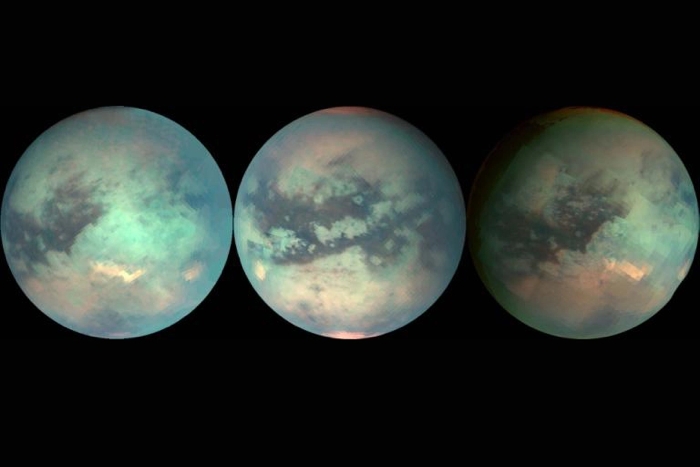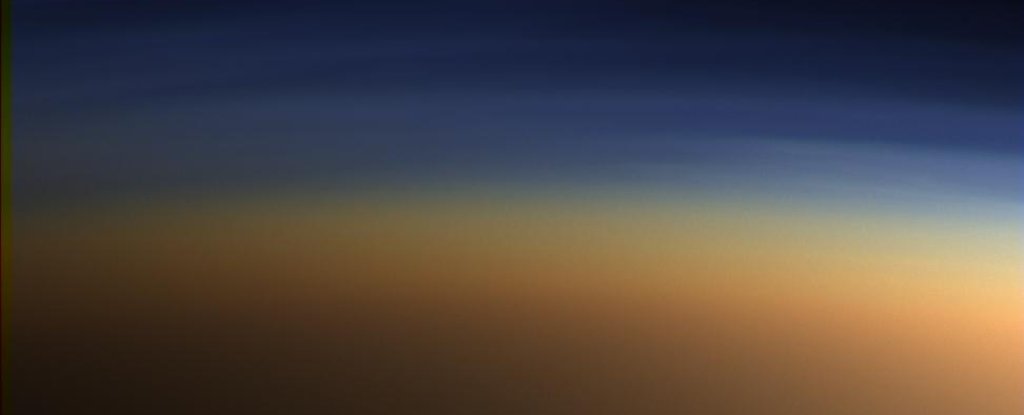Products You May Like
Compared to most places you might wander in the Solar System, Titan – the giant moon of Saturn – is in many ways strangely familiar to Earth.
In fact, Titan is the only moon in the Solar System with a dense atmosphere, providing a number of quasi-Earth-like weather phenomena, such as methane rainfall, which feeds rivers and, in turn, lakes.
While much of Titan’s landscape is very unlike Earth’s, other aspects of the icy moon are not so dissimilar, such as Titan’s towering sand dunes – and yet the existence of these dunes poses something of a mystery.
On Earth, the sediment that makes up sand dunes is composed of inorganic silicates, but the chemistry of Titan’s sand is rather different.
 Mosaics of Titan imaged by NASA’s Cassini probe. (NASA/JPL/University of Arizona)
Mosaics of Titan imaged by NASA’s Cassini probe. (NASA/JPL/University of Arizona)
“Sediments on Saturn’s moon are thought to largely consist of mechanically weak organic grains, prone to rapid abrasion into dust,” a team of researchers, led by planetary geologist Mathieu Lapôtre from Stanford University, explains in a new study.
That rapid abrasion means that over enough time, the sand particles in Titan’s dunes ought to become finer and finer, until they eventually grind away to dust.
This light dust would eventually become so fine, it would blow away in the atmosphere, and be incapable of forming cohesive structures like giant dunes, which require larger, coarser particles to coalesce.
“As winds transport grains, the grains collide with each other and with the surface,” Lapôtre says. “These collisions tend to decrease grain size through time.”
But due to the presence of huge sand dunes on Titan, the researchers suggest some unknown growth mechanism, capable of fortifying the grains and countering the abrasion forces, must be playing out on the moon.
Whatever it is, it’s been going on for a very long time.
“Titan’s equatorial dunes have likely been active for [tens to hundreds of thousands of years],” the team writes. “Sustaining Titan’s dunes over geologic timescales requires a mechanism that produces sand-sized particles at equatorial latitudes.”
In the new research, the scientists propose what this mysterious mechanism might be, inspired by the existence of ooids – small, rounded sedimentary grains found on Earth’s sea floor.
Unlike most other forms of sand (usually formed in the process of breaking down through abrasion), ooids are accretionary formations that build up from smaller particles, through chemical precipitation in the marine environment.
According to the researchers’ modeling, a similar phenomenon could explain the existence of Titan’s own organic sediment, enabling the particles to sinter (compact) together into fused clumps, countering the simultaneous force of abrasion, and maintaining particles at an equilibrium size.
“It readily permits the formation of active sand dunes at equatorial latitudes, with some dust production but no significant dust accumulation owing to sintering of dust grains into sand over time,” the researchers explain, noting their calculations also account for the existence of distinctive sandstone formations on the moon‘s plains and at its poles.
“On Titan – just like on Earth and what used to be the case on Mars – we have an active sedimentary cycle that can explain the latitudinal distribution of landscapes through episodic abrasion and sintering driven by Titan’s seasons,” says Lapôtre.
While the team acknowledges their explanation for Titan’s sedimentary cycle is only a hypothesis for now – as other scenarios cannot be entirely ruled out – they’re confident it’s a match for what we see on this strangely familiar moon, once described as a “deranged version of Earth”.
“We were able to resolve the paradox of why there could have been sand dunes on Titan for so long even though the materials are very weak,” Lapôtre says.
“It’s pretty fascinating to think about how there’s this alternative world so far out there, where things are so different, yet so similar.”
The findings are reported in Geophysical Research Letters.
